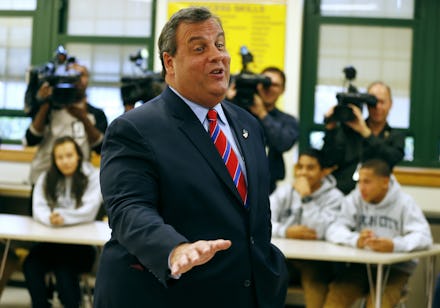3 Reasons Chris Christie's Education Plan is a Model For the Rest Of the Country

America spends more than any country in the world on education, but we are not getting nearly the best results. We spend nearly $10,000 per student per year, yet our students rank 31st in math and 17th in reading, according to OECD Rankings. By contrast, Finland spends about $6,000 per student per year and finishes 3rd in reading and 6th in math. Despite this, the debate on education reform consistently focuses on allocating more resources to schools, and Americans agree. Polls in the mid 2000s found that American adults list “insufficient funding and resources” as the top problem facing public schools in their communities. The fact is, spending more will not solve our educational woes, but spending better will. Here are several suggestions for how to more efficiently spend our dollars in education.
1. Decrease the number of administrators and other non-teaching staff: There are 25 states in which administrators outnumber teachers. This “educratification” of American schools only hurts our children. While many administrative roles are crucial in overseeing districts and schools, it is absolutely absurd that many states have more administrators than teachers. Since when does an industry need more bosses than workers?
Between 1950 and 2009, the number of teachers increased by 252%, while the number of administrators and non-teaching staff grew by 705%. This surge leads to situations like that in Virginia, where in 2010 there were 183.4 non-teaching staff for every 100 teachers. These non-essential jobs should be cut from districts via state-level mandates, and the excess wages should be reallocated to raise teachers’ salaries.
2. Enforce higher standards for teachers: New evidence shows that students learn about one and a half years of content per year from an effective teacher, and half a year of content per year from an ineffective teacher. The same research shows that a teacher in the 84th percentile of effectiveness can increase his or her students’ future wages by $20,000 per year, while a teacher at the 16th percentile causes a decrease in his or her students’ future wages by the same amount.
Unfortunately, due to tenure laws that kick in too quickly and unions that are too powerful, it is nearly impossible to fire a bad teacher. Structural change must occur to solve this problem, and Governors Chris Christie and Pat Quinn have provided perfect examples of it in their respective states. Other states must follow their lead, rewriting laws and negotiating new contracts to create more lenient non-renewal guidelines, decrease the cost burden of the firing process, and make tenure harder to obtain.
3. Offer incentives to attract better teachers: The brightest and best candidates are not attracted to the teaching profession because compensation and opportunities to advance are inadequate. The financial benefits to becoming a teacher do not outweigh the costs of obtaining the requisite degrees. For the average teacher, it takes 22 years to pay off student loans. Or that potential teacher could go to college for engineering, advertising, or pharmacy and pay his or her degree off in about one-third the time.
To overcome this, we should spend more on teacher compensation, and increase efforts to tie compensation to teaching effectiveness. By paying a higher base salary, the field will become more competitive ensuring that the best candidates decide to teach. Once there, bonus packages that pay teachers for student growth and achievement should be paramount in compensation systems, motivating teachers to do a better job at educating their students. The additional funds to be spent on teaching should come from cutting administrative costs.
If the U.S. wants to remain competitive in an increasingly global economy, we must increase the performance of our students. We cannot do this by spending more money, but if we improve the allocation of our resources, we can create a system with better educators and better-educated students.